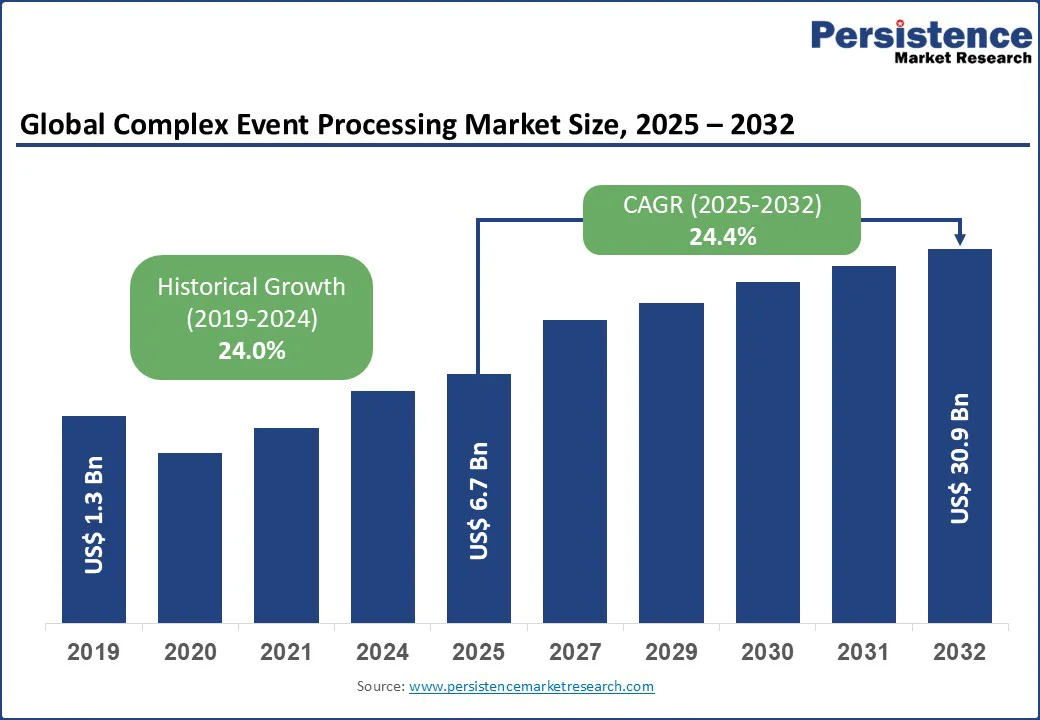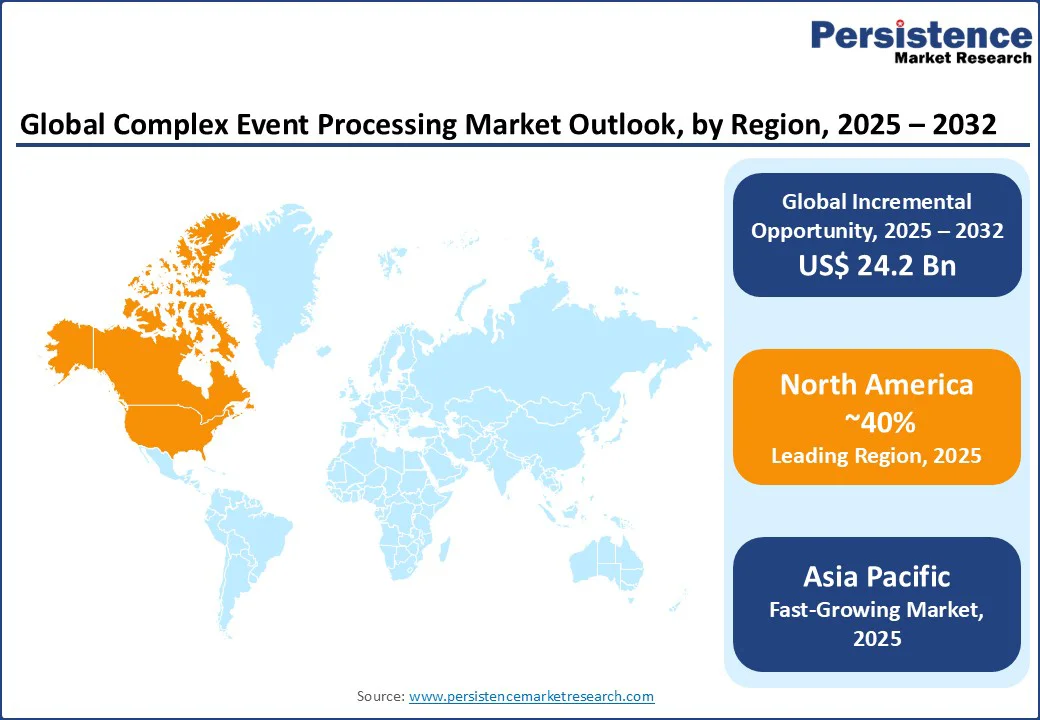ID: PMRREP10816| 196 Pages | 22 Sep 2025 | Format: PDF, Excel, PPT* | IT and Telecommunication

The global complex event processing market size is likely to be valued at US$6.7 Bn in 2025 and projected to reach US$30.9 Bn by 2032, registering a CAGR of 24.4% during the forecast period from 2025 to 2032. This is driven by the unprecedented surge in real-time data from IoT devices. It serves the critical need for instant analytics in industries such as BFSI, telecom, and healthcare.
Key Industry Highlights:

| Key Insights | Details |
|---|---|
|
Complex Event Processing Market Size (2025E) |
US$6.7 Bn |
|
Market Value Forecast (2032F) |
US$30.9 Bn |
|
Projected Growth (CAGR 2025 to 2032) |
24.4% |
|
Historical Market Growth (CAGR 2019 to 2024) |
24.0% |
The proliferation of IoT devices, generating massive data streams from sensors, smart devices, and connected systems, has created a pressing need for real-time processing capabilities. Complex event processing solutions are uniquely suited to handle high-velocity, high-volume data, enabling organizations to detect critical patterns, such as network anomalies in telecom or equipment failures in manufacturing.
In BFSI, CEP processes millions of transactions per second, identifying fraudulent activities with high precision, reducing financial losses significantly. Telecom operators leverage CEP to monitor network traffic in real-time, ensuring seamless connectivity for a larger number of users across 5G networks. The manufacturing sector uses CEP for predictive maintenance, analyzing sensor data to prevent costly downtime, with some firms reporting up to 50% reductions in maintenance costs.
The integration of CEP with big data platforms enhances its ability to process diverse data sources, including social media feeds and transaction logs, making it a cornerstone of data-driven strategies. The rise of smart cities, autonomous vehicles, and Industry 4.0 initiatives further amplifies this driver, as organizations seek CEP to manage complex, real-time data ecosystems effectively.
Deploying CEP solutions requires substantial investment in software, hardware, and skilled expertise, with enterprise-grade implementations often costing millions of dollars. The integration of CEP with legacy systems, prevalent in industries such as manufacturing and BFSI, involves complex customization, leading to deployment timelines of 6-18 months. SMEs face significant barriers due to limited budgets and technical expertise, with many unable to afford the infrastructure needed for high-performance CEP.
Compliance with stringent data privacy regulations, such as GDPR in Europe and CCPA in the U.S., adds complexity, requiring robust security measures such as encryption and access controls, which can increase costs by 20-30%. The global shortage of data engineers and CEP specialists further exacerbates implementation challenges, particularly in regions with limited access to training resources, slowing adoption among smaller organizations.
The integration of CEP with AI and machine learning presents transformative opportunities by enhancing predictive analytics, anomaly detection, and automation. AI-driven CEP platforms improve pattern recognition, enabling BFSI firms to detect fraudulent transactions with higher accuracy and fewer false positives.
For example, banks using AI-enhanced CEP have reported significant improvements in fraud detection rates, reducing financial losses. In manufacturing, ML-powered CEP predicts equipment failures by analyzing sensor data, enabling proactive maintenance, and reducing downtime.
Blockchain integration adds security and transparency to event processing, particularly in supply chain management, where it ensures tamper-proof data logs for manufacturing and logistics. In healthcare, AI-driven CEP supports real-time diagnostics, analyzing patient data to predict health events, potentially lowering costs and improving outcomes. This convergence creates new revenue streams, as organizations across industries seek advanced CEP solutions to address complex use cases in smart cities, autonomous systems, and personalized retail experiences.
Software dominates the complex event processing market, accounting for a 70% share in 2025. These platforms process high-velocity data streams, enabling applications such as fraud detection, where banks analyze millions of transactions per second, and predictive maintenance, where manufacturers conduct a real-time surveillance. The adoption of cloud-based CEP software enhances flexibility, allowing organizations to scale processing capabilities dynamically. Vendors are enhancing software with edge computing support, catering to low-latency use cases such as autonomous vehicles and smart grids, driving widespread adoption across industries.
Services are the fastest-growing segment. Services, including integration, consulting, and support, are critical for customizing CEP solutions to specific industry needs. Consulting services help organizations align CEP with business objectives, such as optimizing supply chains in manufacturing or enhancing customer experiences in retail. The increasing complexity of data environments, particularly in SMEs adopting CEP for the first time, drives demand for specialized services, enabling organizations to maximize the value of their CEP investments.
Large enterprise dominates the enterprise segment, holding a 65% share in 2025. Large enterprises, with complex data ecosystems, rely on CEP for real-time analytics in high-stakes environments such as BFSI, where fraud detection and compliance are critical, and telecom, where network performance is paramount. The segment’s dominance is driven by the need for centralized event processing, particularly in industries with stringent regulatory requirements and high data volumes.
Small and medium enterprises (SMEs) are the fastest-growing segment, as cloud-based CEP solutions lower entry barriers. SMEs in retail leverage CEP for real-time inventory management and customer analytics, while those in healthcare use it for patient data monitoring. Tailored solutions, such as managed services for logistics and retail, address specific use cases, making CEP accessible to smaller organizations seeking to enhance operational efficiency and competitiveness.
BFSI leads the end-use segment, accounting for a 25% share in 2025. The sector’s reliance on real-time fraud detection, transaction monitoring, and regulatory compliance drives CEP adoption. The integration of CEP with AI enhances fraud detection accuracy, making it indispensable for financial institutions navigating complex regulatory landscapes.
The telecom and IT Industry is the fastest-growing end-use, driven by the rollout of 5G networks and IoT applications. The sector’s growth is supported by increasing data traffic, with telecom operators leveraging CEP to manage network congestion and ensure service quality. Emerging use cases, such as IoT-driven smart grids and connected devices, further accelerate CEP adoption in this industry.

North America dominates the complex event processing market, accounting for a 40% share in 2025, driven by its advanced technological infrastructure, robust innovation ecosystem, and high adoption in BFSI, telecom, and healthcare. The U.S. leads the region, with significant investments in IoT and big data analytics fueling CEP demand. In BFSI, U.S. banks use CEP for real-time fraud detection, processing billions of transactions daily to identify suspicious activities within milliseconds.
Telecom operators leverage CEP for 5G network optimization, ensuring seamless connectivity for IoT applications such as smart homes and autonomous vehicles. Canada’s smart city initiatives, such as Toronto’s urban data projects, drive CEP adoption in government and managed mobility for real-time traffic and energy management. Regulatory frameworks, such as the U.S. Sarbanes-Oxley Act and California Consumer Privacy Act (CCPA), mandate real-time compliance monitoring, boosting demand for CEP solutions.
North America’s focus on cutting-edge technologies, including 5G and edge computing, positions it as a market leader, with enterprises prioritizing low-latency, data-driven decision-making to maintain competitive advantages.
Europe is likely to register a 30% share in 2025, led by Germany, France, and the U.K., driven by robust digital infrastructure, Industry 4.0 initiatives, and stringent regulatory frameworks. Germany’s manufacturing sector is a key adopter, using CEP for predictive maintenance and supply chain optimization. Companies such as Siemens deploy CEP to analyze sensor data from production lines, reducing equipment downtime and improving efficiency.
France’s telecom industry leverages CEP for real-time network management, particularly with the rollout of 5G networks, which require low-latency processing for IoT applications. The EU’s Digital Decade initiative, aiming for widespread digitalization by 2030, drives CEP adoption in retail for customer analytics and in healthcare for patient monitoring. GDPR compliance requirements fuel demand in BFSI, with banks deploying CEP to monitor transactions and ensure data privacy in real-time.
Vendors such as Software AG and SAP offer tailored solutions, with cloud-based platforms gaining traction for their scalability and integration capabilities. Europe’s focus on sustainability, smart infrastructure, and data-driven innovation supports CEP growth, with cities such as Paris and Berlin adopting real-time analytics for urban management and energy optimization.
Asia Pacific is the fastest-growing region, accounting for a 25% share in 2025, driven by rapid IoT adoption, digital transformation, and government-led smart city initiatives. China leads the area, with projects such as Shanghai’s smart city framework using CEP to manage real-time data from traffic systems, energy grids, and public safety networks.
Chinese telecom operators deploy CEP for 5G network optimization, supporting applications such as autonomous vehicles and smart manufacturing. Japan’s focus on Industry 4.0 drives CEP adoption in manufacturing, with companies such as Toyota using it for predictive maintenance and supply chain analytics. The region’s growth is fueled by increasing data volumes, with enterprises adopting cloud-based CEP solutions from AWS and Google Cloud to process high-velocity streams. Government initiatives, such as China’s 14th Five-Year Plan, promote digital infrastructure, further accelerating CEP adoption.

The global complex event processing market is highly competitive, with FICO, Kx Systems, Oracle, Amazon Web Services, TIBCO Software, StreamBase Systems, SAP, IBM, Axon Framework, Microsoft Azure, Google Cloud Platform, collectively holding over 70% of the market share. These players dominate through innovation, offering cloud-based, AI-integrated, and edge-enabled CEP platforms tailored to industry-specific needs. Oracle and IBM lead with enterprise-grade solutions such as Oracle Event Processing and IBM Streams, widely adopted in BFSI for fraud detection and in manufacturing for predictive maintenance.
Amazon Web Services and Microsoft Azure dominate cloud-based CEP, providing scalable platforms for telecom and retail. TIBCO’s StreamBase and Software AG’s Apama offer flexible solutions for hybrid deployments, while smaller players such as EsperTech and Axon Framework focus on open-source and niche applications, gaining traction among SMEs and developers in media and entertainment.
The global complex event processing market is projected to reach US$ 6.7 Bn in 2025.
The market is driven by the surge in IoT and big data, demand for real-time analytics, and advancements in cloud and edge computing.
The market is expected to grow at a CAGR of 24.4% from 2025 to 2032.
Integration with AI/ML and blockchain, and expansion in emerging markets and SMEs, offer significant growth potential.
Oracle, IBM, SAP, Amazon Web Services, and TIBCO Software are among the key players.
| Report Attribute | Details |
|---|---|
|
Historical Data/Actuals |
2019 - 2024 |
|
Forecast Period |
2025 - 2032 |
|
Market Analysis |
Value: US$ Bn, Volume: As Applicable |
|
Geographical Coverage |
|
|
Segmental Coverage |
|
|
Competitive Analysis |
|
|
Report Highlights |
|
By Product Type
By Enterprise
By End-use
By Region
Delivery Timelines
For more information on this report and its delivery timelines please get in touch with our sales team.
About Author